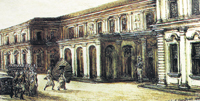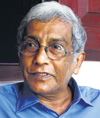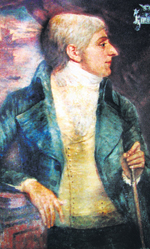|
|
|||||||||
|
An enlightening and stimulating read Vesak Sirisara – 2006. Edited by Rajah Kuruppu.Reviewed by T.B. Ratnayake Vesak Sirisara, the trilingual Buddhist annual publication by the Government Services Buddhist Association, made its 71st appearance on the eve of the 2550th Buddha Jayanthi which fell on Vesak full-moon day this year.
This Vesak Journal originally published by the Sri Saddharmadana Samitiya of Saranapalaramaya, Wadduwa, was started by four teenagers in 1935. One of the founder-patrons and co-editors of the journal, Ven. Keselwatte Jinananda Nayake Thera passed away in 1984, and another co-editor H.P. Jayawardena, the late Nayake Maha Thera’s brother in lay life, continued to edit the journal till 1992. The present publisher, the Govt. Services Buddhist Association took over the publication 15 years ago. It is now being edited by Rajah Kuruppu, assisted by Dhamma Weerakoon and T. Kanakaratnam. The current issue is a carefully edited, attractively printed compilation of articles and poems both profound and simple, by Buddhist scholars on different aspects of the Buddha Dhamma. Most of the articles in the Sinhala section are of high academic nature. “From Saddha to Panna” by Ven. Koswatte Ariyawimala Thera, “Those who need be diligent” by Ven. Panadure Dhammarakkhita Thera, “Complexity of Tanha” by Ven. Nabirittakadawala Nanaratana Thera are some such articles which delve deep into the relevant fields. Ven. Attudawe Sri Rahula Mahanayake Thera’s article on “Contentment” explores the importance of being satisfied with having little. Ven. Kotugoda Dhammawasa Anunayake Thera in his article, “Was Alavaka truly a demon?” proves that Alavaka was not a demon, but a human being- a chieftain of the yakkha clan. The importance of studying the Dhamma and the ways in which it should be practised is brought out by Chandrapali Dissanayake in her article “From Darkness to Light.” “Buddha’s teaching on the world” by D. Saddhasena, “Sinhala Commentaries” by Dr. Siripala Maduwage and “Theravada and Mahayana Buddhist thoughts” by Dr. Siri Nissanka Perera are well-researched articles providing a lot of information. Citing the Cakkavatti Sinhanda Sutta and the Kutadanta Sutta, Dr. Dharmasena Hettiarachchi explains in a simple manner, how economy, governance and morality are inter-related. “That, indeed, is your father, the lion of man”, by Upali Ranige is a commendable rendering in verse, although there are a few inexactitudes in the translation. Daya Mohotti gives a summary of the Sigalovada Sutta in verse. The Tamil section carries three articles by T. Kanakaratnam, Dr. Jinnah Sheriffdeen and Ruwan Banda Adhikari. There are 23 articles in the English section, including four contributions in verse. As constraints of space would not permit me to comment on all these articles, I am compelled, though with reluctance, to limit myself to a few articles only. Olcott Gunasekera in his article, “2550 Buddha Jayanthi”, shows clearly how modern lop-sided development has eroded many of the age-old Buddhist values. Ven. Olande Ananda Thera’s memorial address to commemorate the third death anniversary of late Deshabandhu Alec Robertson is reproduced as “The Art of Living: Vipassana Meditation.” Madawala Hemananda, a fellow of the Royal Institute of Chartered Surveyors, London, and a founder member of the Thames Meditation Society in England, writes a comprehensive, instructive article on “Practice of Buddhist Meditation”. Bhikku Bodhi’s article on “The Nobility of the Truths” explains the Four Noble Truths in a concise manner. Professor G.P. Malalasekera, one of the most erudite Sri Lankan Buddhist scholars of world-wide repute, in his discussion of “Rebirth and the Doctrine of No-Soul” says, “In its denial of any real permanent soul or self, Buddhism stands alone. This preaching presents a difficulty to many people and often promotes even violent antagonism towards the whole religion. Yet, this doctrine of No-Soul or Anatta is the bed-rock of Buddhism and all the other teachings of the Buddha are intimately connected with it." In explaining re-birth, he says, “What is important to the Buddhist is not death or re-birth, for these processes are always taking place in our present life, but the fact that the quality of life which succeeds death is entirely in his own power and that his future environment will depend entirely on him.” D. Amarasiri Weeraratne, in his contribution written just before his passing away, discusses different aspects of Anatta citing both Theravada and Mahayana interpretations. Professor Arjuna de Zoysa too, in his article “Anicca, Dukka, Anatta”, The Timeless characteristics of "Reality” confirms that “Anatta is an observation unique to Buddhism: no other religion or science has understood this in its completeness.” He quotes not only Buddhist texts, but other scriptures such as the Bible and the Bhagavat Gita as well to show how “Anicca” has been understood and expounded by religious teachers of diverse faith. Ven. Dr. M. Vajiragnana Thera, Head of the London Buddhist Vihara and Sangha Nayake of Great Britain, Ven. Walpola Piyananda Thera, the Chief Sangha Nayake of America, Dr. Susanga Weeraperuma of France, Ajahn Khemananda of Thailand, Asoka Devendra, Asoka Jayasinghe and several other renowned Buddhist scholars have contributed immensely to enhance the value of this bumper issue of the Vesak Sirisara, 2550, running to over 200 pages. Quoting the experiences of Ven. Dhammanissayo Thera and S.N. Goenkaji, the editor Rajah Kuruppu proves convincingly the therapeutic value of observing mindfulness or bhavana, in overcoming and healing certain illnesses. Many of the articles, both in Sinhala and English, would be of sustained interest not only to Buddhists, but also to those who profess other faiths. The editor deserves our congratulations for painstakingly getting up such a valuable Vesak Annual.
From governor’s house to all the presidents’ house
The magnificent building lies in the heart of Fort in Colombo, at present heavily guarded and hidden from the public eye. Known today as the 'Janadhipathi Mandiraya' or 'The President's House', it is over 200 years old and has been home to many Governors of colonial times before it became the official residence of the Presidents of Sri Lanka. It is a house that has witnessed many changes in the country's history; if its walls could speak they would tell many a colourful tale.
Taking a journey through the rich past of the building, Dr. K.D.G. Wimalaratne's book, 'The President's House; Sri Lanka, From a Private Residence to President's House' launched on Thursday, tells the story of its beginnings, its occupants and their distinguished visitors, its architectural splendours and details of its interior as well as the many renovations it has undergone during the stay of each occupant. Numerous drawings, paintings and photographs illustrate each page.
Built in 1790, the house was originally the private residence of Dutch Governor, Johan Gerrard Van Anglebeek. It was a turbulent period in the country's history when the Dutch were about to hand over the rule of the country to the British. Strangely enough, the transition from a private house to an official residence began with an old fashioned love story.
The Dutch Governor's granddaughter fell in love with the first Auditor General-then known as the Accountant General-the Englishman Melvin Lesley. When the AG was found by the British Government to be short of over thirty thousand pounds, it fell on the Dutch Governor to safeguard the family honour, and in exchange for his future grandson-in-law's good name, he offered his house to the Government, after which the entire family moved back to their homeland. Thus, from 1804 the house became the official residence of the British Governors. The book reveals many interesting anecdotes about its occupants as well as the historic discussions that took place within its walls. For instance the discussion which took place in 1921 between Governor William Manning, Sir Ponnambalam Ramanathan and Sir Ponnambalam Arunachalam which led to the formation of the Jaffna Mahajana Sabha. This, says the writer, was the first division of the community into a majority and minority. The book also reveals how, during the tenancy of Governor Horton in 1833, they found bullets embedded within the walls of the house during renovations. These bullets were said to have been discharged by the rebellious Malay soldiers during the capitulation of Colombo to the British. In 1902 the building was named 'The Queen's House' in honour of Queen Victoria. The historic park of the President's House, the Gordon Gardens, was a gift from the Governor Gordon to the people of Colombo, and could be visited by the public during that period. Many of the garden's landmarks are described in the book, which remain there to this day. Among these are the magnificent rock shipped from Portugal, and the famous Nuga tree that stands guard over the garden. At present the house is being renovated once again in preparation for its latest occupant, President Mahinda Rajapaksa, who is yet to set his stamp upon this imposing building. Author, Dr. Wimalaratne is the former Director of National Archives and a visiting lecturer in Information Management and Conservation of Archives and Library Materials in the Department Of Library And Information Science, University of Kelaniya. The book is based on years of research on the subject. At present he is working on a book on the National Symbols of Sri Lanka. |
|||||||||
Copyright © 2006 Wijeya Newspapers
Ltd. All rights reserved. |



